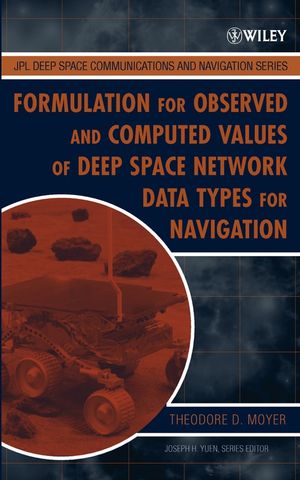Formulation for Observed and Computed Values of Deep Space Network Data Types for NavigationISBN: 978-0-471-44535-7
Hardcover
576 pages
January 2003
 This is a Print-on-Demand title. It will be printed specifically to fill your order. Please allow an additional 10-15 days delivery time. The book is not returnable.
|
||||||
A valuable reference for students and professionals in the field of
deep space navigation
Drawing on fundamental principles and practices developed during decades of deep space exploration at the California Institute of Technology's Jet Propulsion Laboratory (JPL), this book documents the formation of program Regres of JPL's Orbit Determination Program (ODP). Program Regres calculates the computed values of observed quantities (e.g., Doppler and range observables) obtained at the tracking stations of the Deep Space Network, and also calculates media corrections for the computed values of the observable and partial derivatives of the computed values of the observables with respect to the solve-for-parameter vector-q. The ODP or any other program which uses its formulation can be used to navigate a spacecraft anywhere in the solar system.
A publication of the JPL Deep Space Communications and Navigation System Center of Excellence (DESCANSO), Formulation for Observed and Computed Values of Deep Space Network Data Types for Navigation is an invaluable resource for graduate students of celestial mechanics or astrodynamics because it:
* features the expertise of today's top scientists
* places the entire program Regres formulation in an easy-to-access resource
* describes technology which will be used in the next generation of navigation software currently under development
The Deep Space Communications and Navigation Series is authored by scientists and engineers with extensive experience in astronautics, communications, and related fields. It lays the foundation for innovation in the areas of deep space navigation and communications by conveying state-of-the-art knowledge in key technologies.
Drawing on fundamental principles and practices developed during decades of deep space exploration at the California Institute of Technology's Jet Propulsion Laboratory (JPL), this book documents the formation of program Regres of JPL's Orbit Determination Program (ODP). Program Regres calculates the computed values of observed quantities (e.g., Doppler and range observables) obtained at the tracking stations of the Deep Space Network, and also calculates media corrections for the computed values of the observable and partial derivatives of the computed values of the observables with respect to the solve-for-parameter vector-q. The ODP or any other program which uses its formulation can be used to navigate a spacecraft anywhere in the solar system.
A publication of the JPL Deep Space Communications and Navigation System Center of Excellence (DESCANSO), Formulation for Observed and Computed Values of Deep Space Network Data Types for Navigation is an invaluable resource for graduate students of celestial mechanics or astrodynamics because it:
* features the expertise of today's top scientists
* places the entire program Regres formulation in an easy-to-access resource
* describes technology which will be used in the next generation of navigation software currently under development
The Deep Space Communications and Navigation Series is authored by scientists and engineers with extensive experience in astronautics, communications, and related fields. It lays the foundation for innovation in the areas of deep space navigation and communications by conveying state-of-the-art knowledge in key technologies.



